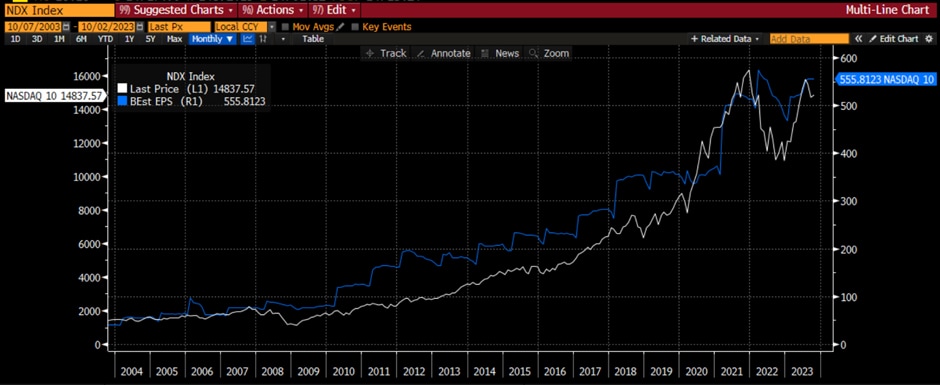Excell with Options: Hedging the FOMC meeting using a Nasdaq-100 futures replacement strategy
Executive summary
Explore the latest Excell with Options as Rich Excell discusses the NDX Index, Fed Funds discount rate, 10-year U.S. Treasury yield and more.
Image 1: NDX Index price vs. earnings over the last 20 years
Those who follow the stock market are likely aware of the positive drift to stocks. Earnings tend to drive stocks, and earnings are driven by the economy. The economy also tends to grow over time; thus, this positive economic growth can lead to index earnings and price appreciation. This is often truer at the index level than the single stock level as there may be idiosyncratic losers in the economy and market but while the index composition may change, the index itself should have this positive drift effect.
The chart above demonstrates exactly what I am talking about as the index price and the index earnings estimate both move higher over the longer term. When there are hiccups in the economic view, the index and the earnings forecasts tend to fall. In places with weaker economies that do not grow as much over time, I see stagnant stock prices. Nothing says indexes must rise. It is something that a generation of investors in the West have become accustomed to, however.
Image 2: NDX Index expected earnings growth for this year and the next two years
To be successful, I try to have a good idea of what the consensus expects for earnings growth in the next year or two. If I want to invest in the index right now, I need to understand the level of expectations for this growth, so I know whether I am paying too much for the index at this price. Looking at the consensus estimates for this year and the next two, I can see that over 21% growth is priced in for this year, with almost 17% for next year and 14% in the following. These seem like pretty lofty growth expectations for an index and an economy that has just seen the central bank raise rates by 5.5% over the last 18 months. Historically, the NDX Index has been faster growing than its SPX peer, with NDX earnings growing at 12% on average for the last 20 years compared to 7% for the SPX. These expectations are higher than even those historical averages, suggesting some very strong times ahead.
Image 3: NDX Index earnings and sales surprises
The bar is high, so I want to consider how likely it is for stocks in the index to outperform. Looking at the earnings and sales surprise metrics for the last several quarters, I can see the big drop off in performance in Q2-Q4 of 2022, which coincided with the struggles of the equity indexes at that time. The better surprise performance this year has led to a better market performance. However, with a very high bar as we begin earnings season, will we expect a surprise in the 5-10% range as we saw in 2021 and 2023 or will this number be closer to 0?
Image 4: NDX Index price, earnings, and forward P/E ratio
Another thing to notice is that the market often anticipates what will happen with earnings. We see this typically at inflection points as the multiple that investors will pay for earnings moves before the earnings themselves move. As a multiple is a measure of investor sentiment, an improvement is simply an indicator that the investors are getting more optimistic about earnings going forward and vice versa. You may hear people say that the market now must “grow into its multiple.” This just means the multiple rallied in anticipation of earnings growth, and now we need to see it.
This is what happened from late 2022 and through most of this year. In fact, I can see that the rally over the last 12 months has been driven largely by the increase in multiple. Earnings have started to catch up, and this sets up Q4 as a very important quarter to gauge whether the multiple being paid now – which is off the 2021 highs but still well above anything else in the last 15 years – is justified or not. This quarter’s earnings and the outlook for next year will go a long way toward proving or disproving these views.
Image 5: NDX and SPX forward P/E ratios vs. the 10-year U.S. Treasury yield
Speaking of multiples, you can see from this graph that they tend to be negatively correlated to 10-year Treasury yields. As yields fall, cash flow expectations further out will often be discounted back at a lower rate and therefore can lead to improving target prices. This tends to improve investor sentiment and multiples. Conversely as yields rise, multiples often fall because cash flows have a higher discount rate, and this can diminish expectations.
This is particularly true for technology and biotechnology because many of them have little if any current cash flow and are supported by distant expectations. Thus, yields and multiples often play a bigger part in these stocks and the NDX Index. One can see that on this latest move higher in 10-year Treasury yields, multiples have taken a turn for the worse. This has led to the rough quarter the market has faced of late. Can it continue?
Image 6: 10-year U.S. Treasury yield and Fed Funds discount rate
The Federal Reserve has historically stopped hiking rates when the Fed Funds discount rate exceeded the 10-year Treasury rate. This time, though, with the Fed Funds a full 100 basis points higher, the Fed is still talking a tough game on rates. This has some observers concerned about a potential policy error. This also means that the next FOMC meeting in November will be closely watched by equity investors and traders alike.
Image 7: Expectation for Fed Funds at the next FOMC meeting
CME Group has a FedWatch tool that allows traders to ascertain what the market is pricing into the futures market for the next meeting. We can see from this tool that the market feels there is a 27% probability that the FOMC will raise rates at the next meeting at the moment. The Fed being on pause, or Peak Fed as some have dubbed it, has been the argument to get long the equity market. If this were to change, it might suggest a recalibrating of expectations. It certainly could give more credence to the concerns some have that the Fed may go too far in this rate hike cycle.
Image 8: NDX Index implied volatility skew
I can see these concerns in the skew priced into the implied volatility market. While there tends to be positive skew for the index puts over calls, this traditional profile was lacking earlier this year when investors were still underweight equities after a difficult 2022. Since I now see a typical index skew with puts price over both at-the-money options and out-of-the-money call options, this leads me to think that investors have returned to equities and are using the options market for either insurance via puts or incremental yield from over-writing calls.
This skew makes it potentially difficult or costly for an investor to hedge their portfolio as we head into an important earnings season and FOMC meeting. What can a trader do?
Image 9: Expected return and Greeks for NDX Index November 3 futures replacement strategy
A trader looking to protect their position can buy options since the long convexity provides for the insurance and favored payoff profile. However, the natural options to buy – puts – are being priced at a premium. One may prefer to buy calls that are being priced at a discount, but that may not give the trader the net exposure they want. However, buying calls can give that exposure if a trader uses a futures replacement strategy, selling their index exposure and replacing it with call exposure instead. The trade I have set up here is selling futures against their existing holdings and replacing the notional amount by buying one call option. For this example, I am choosing to buy the November 3 expiration that captures the November 1 FOMC meeting as well as the first month of earnings. By this time, I should have a read on how the earnings season is developing and will have a much better idea if the FOMC has indeed finished hiking rates for this cycle.
We can see from the payoff diagram that this futures replacement strategy has the profile of a long put option. I would benefit more on a sell-off than on a rally. If the market were to rally, the premium spent essentially was wasted. However, if the market sells off, the breakeven is close to current prices and the payout is unlimited.
This can work not only as a hedge but also to play the downside of the market for someone who is quite bearish too. A trader can create this synthetic put even with no initial position, selling the market ahead of the earnings and FOMC catalysts and using the call option as protection. The resulting in the money put option profile may be considered a bit riskier than an out of the money put option because of the higher premium implied by the parity value involved. However, given there is limited downside to the option purchase, that being the premium spent, it may be considered less risky than simply selling the futures.
Looking at the skew in the market and trying to take advantage of the relative pricing is the job of the trader. If we understand Put-Call parity and how we can create synthetic options profiles, as traders, we can create the desired profile and improve our portfolio’s risk-reward trade-offs.
Good luck trading!
To subscribe to new issues of this report, visit cmegroup.com/excellwithoptions
The opinions and statements contained in the commentary on this page do not constitute an offer or a solicitation, or a recommendation to implement or liquidate an investment or to carry out any other transaction. It should not be used as a basis for any investment decision or other decision. Any investment decision should be based on appropriate professional advice specific to your needs. This content has been produced by [Data Resource Technology]. CME Group has not had any input into the content and neither CME Group nor its affiliates shall be responsible or liable for the same.
CME GROUP DOES NOT REPRESENT THAT ANY MATERIAL OR INFORMATION CONTAINED HEREIN IS APPROPRIATE FOR USE OR PERMITTED IN ANY JURISDICTION OR COUNTRY WHERE SUCH USE OR DISTRIBUTION WOULD BE CONTRARY TO ANY APPLICABLE LAW OR REGULATION.

